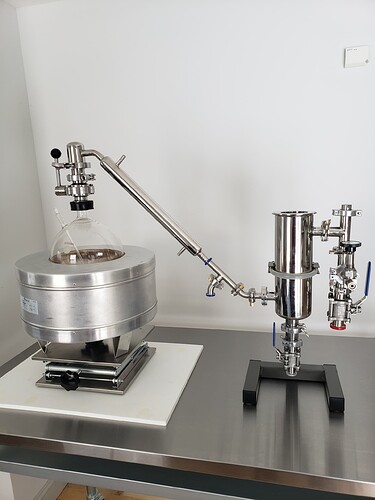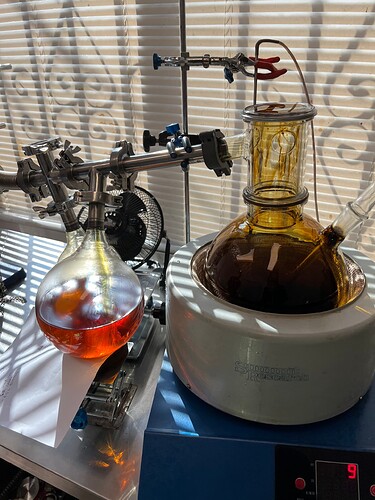deleted
At the moment I don’t have plans to add jacketing. Hear me out!
Vacuum Jacket: vacuum jackets protect the distillation core by shielding the core from some level of outside cooling. We can sort of think of the outside cooling as blowing air or “wind”. Protecting the core of a distillation column in a windy environment is helpful during heat up, during mains, and at the end of mains. Vacuum jackets are especially helpful when the system is small (less than 5L) where almost any level of windiness could effect the core. In a large system (5L or bigger) and in a non-windy environment, this head functions very well without additional jacketing of the core. If you notice, the core is sort of vacuum jacketed as designed where the vapor flow is internal to the head and the wind can be blocked by the outer jacket of the head (see figure 2).
Adding a vacuum jacket would add large amounts of weight and cost to the system. Aside from the increase in cost, increasing the mass of steel above the boiling flask will also require an increase in energy to equilibrate that head with the system. Unless the environment is really windy and the core can’t get up to temperature, I think vacuum jackets won’t help much here.
Liquid Jacket: I have never personally used a liquid jacketed head but here are my understanding. The heated liquid jacket is not only protecting against wind but it solves the issue of increased energy to equilibrate the system. With a pre-heated head, the mantle/boiling flask no longer have to indirectly heat the jacket/core combination. The jacket and core are ready to go from the start in this case. I think this is a solid design idea.
My goal has been to keep things simple. Blocking wind with the layered core design and relying on the material in the flask and vapor in the column to heat the column has worked well in this system.
This is a very cool design. Try as i might I’m having trouble wrapping my head around the flask that appears to be “upside down”. The one pointing up in the air, what function does it serve in the system?
thanks
that one is turned down to catch mains. saves breaking vac
This is neat, like the glass ball flasks on a stainless vkd wiper.
Can’t wait to see this thoroughly tested by several labs and time elapse videos of complete runs with yield data and final analysis on distillate would be great.
Hopefully you guys perfect this and market it effectively before a competitor adopts the design.
Here’s my version. Simple, clean, and have no idea if it works yet. 5l early bird special deal $5999. Lol.
i love that heating mantle. looks like a damn flying saucer in a cheap 70’s movie
Straight out of the Jetsons!
3 posts were split to a new topic: @ficklepickle off topic
Got any results on potency? Does this do a pretty solid job of separating fractions?
Trust me, after using one you wont love it as much. Glas-col is a great company, but their mantles suck balls for short path distillation of cannabis. There is a cold spot that is not heated at the bottom to protect the magnetic path for stirring, and it makes it so that your oil will take forever to begin stirring. The whole flask could be 120C and there will be a small blob of frozen oil that is trapping the stir bar. Very frustrating and I have never had that problem with any other mantle. Just my two cents, a lot of people use them (including me until I splurge on nice summit one, I have a 500ml, 2L, 5L, and 20L glascol)
I’m hoping to have a video of this specific system working soon!
The first version of this system has been in use since July 2020 and has shown no signs of issues. The v2 is admittedly a new design but it is already a significant improvement for the larger flasks.
I’m aiming to video this system distilling terpenes, distilling cannabinoids on first pass and second pass, and also distilling water clear to show it can do that if the input is correct.
Couldn’t agree more. There are a lot of subpar mantles out there.
My recommendation at the moment is Across International. It seems to me their mantle functions as advertised and the controls are simple.
This system does a great job at separating fractions.
Shown here is a glass version of the head during cool down of a hemp distillation. You can see the large volume of chlorophyll saturating the head while clear oil was able to collect in the condenser.
All of the other short paths on the market (no exageration) attempt to collect liquid inside the head using a ridge near the condenser. The ridge collects the liquid during transition states in distillation when the column has not equalized with the boiling flask. After the column is up to temperature, liquid in the column is ideally rejected.
By designing a system that focuses on rejecting splashing liquids in the head, we created a system that can distill more pure fractions at lower temperatures.
so the head is rotated depending on desired flow?
Correct. The steel system has multiple different sized outlets on the internal column. That allows you to distill with speed or with care depending on the input material.
The glass design can be rotated to block the condenser from the outlets but the holes are all the same size in this case. Rotating away from the condenser works well for collecting very volatile compounds but it seems to sort of seize up THC distillation and slows it down considerably. Too much rejection causes slow distillation and isomerization, especially in the larger systems.
Oh that’s a very interesting feature! An anti-bumping mechanism is definitely something you don’t see much.
Looks like a pretty sweet set up you got here. What kind of throughput are you achieving with each system?
At a boiling flask temperature of 180C and an Edwards30 vacuum pump (10 micron) the rendered system runs at about 500g/hour in the 5L size and about 900g/hour in the 10L size.
The glass head pictured is faster but I’m not sure exactly the number. When it comes to the speed of the head under vacuum, speed is really just determined by the size of the tube inlets/outlets, the physical barriers in the way of vapor, and the height of the column.
I’ve designed this to have a reasonable amount of restriction but still operate fast enough to avoid degrading THC into the other isomers or CBN. This way very low quality material can be transformed into high quality distillates at a reasonable pace.
If you want more speed than quoted above we can make you something faster by expanding the diameter of the column


